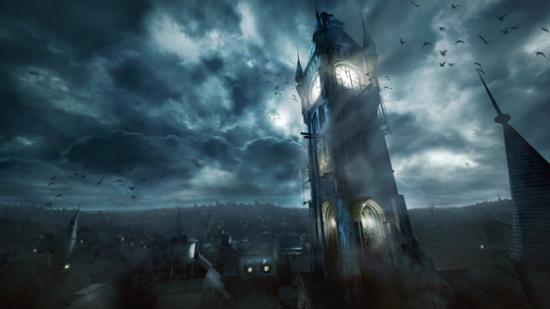There’s not a whole lot more Eidos Montreal can do or say to further alienate die-hard Thief fans at this stage. Maybe they could show Garrett rocking out on an electric guitar, pulling off tasty riffs to disorientate and confuse guards while he skateboards through a museum. Maybe they could reinvent him as a wise-cracking cat, collecting coins and doing backflips to grab hard to reach goblets, while on a companion app you control a mouse who must arrange a grid of loot into matching sets of three to unlock in-app purchases. Almost everything the studio says or does, almost every trailer and statement they have released, punts Nu-Thief ever further from Thief Classic and makes people grumpy.
Which is really weird, because this game actually plays a lot more like the old Thief games than the studio has let on. New Thief feels like old Thief. Despite Eidos Montreal’s counter-productive bleating about franchise reinventions and gritty reboots, Garrett is pretty much still Garrett, except with special eyes and takedowns.
It’s like Thief in as much as you climb through windows at night and click on anything shiny to dump it into your magic bottomless loot sack, triggering a familiar magpie instinct as you indiscriminately swipe other people’s belongings. Everything is auto-fenced for cash, which can be spent on stuff. Appropriately, it’s a magpie who delivers Garrett details of his next mission, via secret magpie messages flown to his secret hideout atop a haunted clocktower. The magpie doesn’t talk, that would be silly, but he does have little correspondence matchboxes tied to his feet by Basso, a quest-giver who lives in the city below.
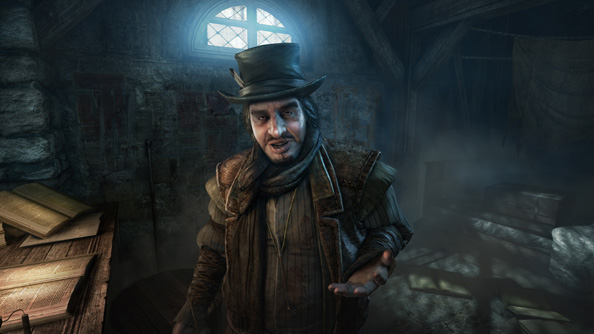
Basso magpie-summons Garrett at the beginning of the hands-on preview session, which takes place in one area of one district of the city, the same area in which Garrett’s clocktower is situated. Before you leave you can look at his empty cases of nothing, which we’re told will later (after progressing in the story) be filled with special loot that Garrett procures and holds dear. But soon you will tire of his barren cases of anticipatory velvet slots and head for the open window, through a loading screen and out into the quasi-Victorian stonework and cobbles of the outdoors. Thief’s city looks and sounds deceptively like the dialed-down districts of Dishonored’s Dunwall, but less steampunk, less surreal, darker and colder. Weirdly enough, echoing Dunwall’s own mysterious plague, this city is under the curse of its own strange disease.
Guards speak of symptoms as you skulk first-personally along the rooftops and balconies above the streets, staying out of the well-lit squares and sticking to the shadowy, excessively balconied urban canopy. The rooftops aren’t entirely free to roam, rather there are a few routes and pathways that broadly mirror the layouts of the roads below, with a few opportunities to take shortcuts, or to use arrows to knock down wooden bridges and create new paths. Garrett can break locks on ladders to extend them to street level, or use rope arrows on special beams to create a means of clambering back up to the rooftops. Otherwise, moving from the street to the rooftops can be achieved by climbing up crates or hooking on to highlighted grates.
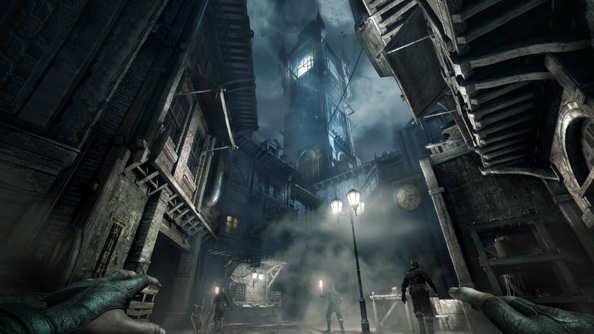
You don’t have a jump button, instead you have something similar to Assassin’s Creed’s free running button. Hold down this button and Garrett will run, or jump across gaps, or vault over waist-high obstacles, or climb up ledges. There’s fluidity to his movement, but it’s a stealthy, feline sort of swiftness rather than something noisy and ostentatious. When moving at a normal pace Garrett also has the ability to “swoop” a few feet in any directon, useful for moving between shadows while remaining next to invisible (and looking rather cool).
If that sounds very much like Dishonored’s magical teleporting “blink” ability, I can tell you that it feels almost identical in practice. Similar too are the dual health and focus bars that are replenishable using consumable items, which ultimately leads to an unflattering and inevitable comparison to Arkane’s much lauded neck-stabbing FPS. At first impressions, Thief is no Dishonored. There’s seemingly less of the raw design cleverness inherent in Dishonored’s locations: its subtly interacting systems, its gentle coaxing to use your abilities and tools, its flexible and exploitable guard AI.
Nor — to drag the unfortunate comparison out, as Thief just begs you to — is the city as fantastically beautiful or expository. Where every building in Dunwall seemed hand-drawn and every street seened an artistic labour, Thief’s city (the small part we had access to, it must be stressed) is easy to get lost in. It’s denser and more claustrophobic, more angular and repeating. Other districts may be more uniquely eye-pleasing, and maybe elsewhere guards will pose more interesting problems and your tools and abilities will provide cleverer solutions, but the morsel of Thief we’ve seen looks dull next to the precocious younger brother from which it so evidently draws inspiration. Dishonored stole from Thief, but it’s not giving anything back.
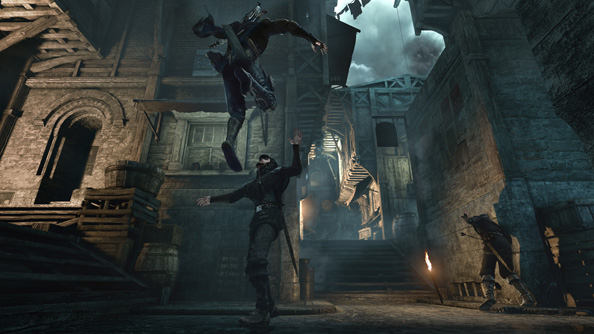
On reaching Basso, you’re given four missions to take on. You can track one objective at a time, using the map to lead you to your mark before swiping the goods and making your escape. Some jobs led to more work: by examining documents and letters you can discover side-missions and unique trinkets. In one case you learn of a tailor’s mechanical hand, locked in a safe while thugs overturn his workshop. In another you must climb into a closet, retrieve a safe code and smack some girl’s dad to retrieve her jewellery. Hidden trapdoors and safes can be found by running your fingers around the frames of paintings to find secret switches, or along a bookshelf to find a trick book that unlocks a revolving door. Real Sherlock stuff.
Thief feels very hands-on, it’s a touchy feely game, with Garrett’s on-screen hands always stroking and pawing at his surroundings. In one instance, when examining a painting of a nude woman for clues, Garrett automatically puts his palms flat against her pixelated bum. It was probably a fluke, but it was the funniest thing to happen in my time with the game. The bum thing, as well as whenever the black market dealer says, “I have something for all your nefarious deeds,” as if that’s ever a thing a real person would say to another human. The hands do add a strange sense of position within the world though, more so than in most other games. It’s a Mirror’s Edge style body awareness effect.
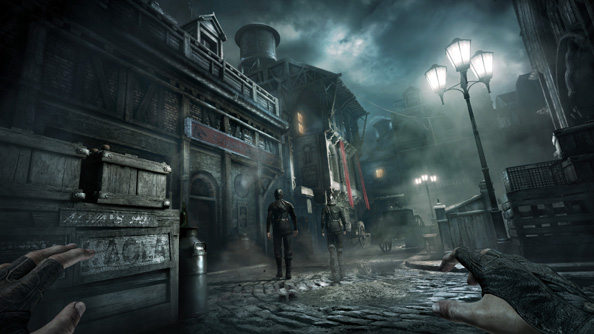
Combat wasn’t something that happened often in the Stonemarket district. The few playable missions could be carried out almost entirely without encountering guards, though by forcing enemies into fights I found that frantically swinging Garrett’s blackjack is a semi-successful tactic, even against multiple opponents. Deus Ex style finishing animations can be triggered by inflicting enough damage, at which point a guard gets down on one knee and accepts his fate, and by using the limited focus ability you can target and attack specific body parts to better murder foes, somehow.
Fighting in Thief is as clunky and uninteresting alternative to proper sneaking as it’s ever been, only in this game it seems to be less fatal, less of a fail state. Thankfully running away into the shadows works too. Break line of sight with guards and they’ll begin searching for you, before eventually getting bored and wandering off.
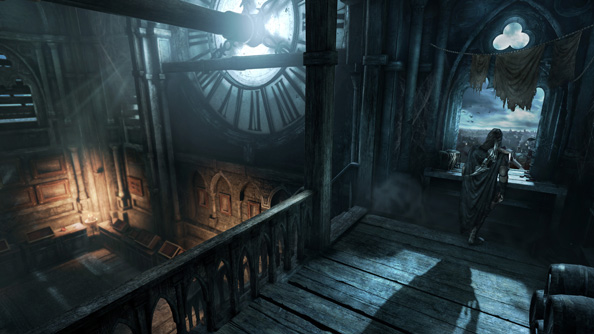
Depending on how your brain works, that reduced threat of triggering a guard response might undermine the stealth aspects of the game. This game feels most like old Thief when it has you shovelling loot into a sack in a darkened room that you’ve reached without alerting a single guard, not when it reverts to brawn over brains, balls out violence. And knowing that the guards now pose less of a threat to a newly empowered Garrett chips away at the scale of the challenge you’re overcoming by avoiding them. A ghost playthrough of the tailor mission I mentioned felt more for the benefit of an achievement marked on a menu screen rather than something burnt into the game’s DNA.
So new Thief is a lot like old Thief, but it’s also not a lot like old Thief at the same time, and it risks wilting in the shadow of Dishonored by failing to differentiate itself from that game. It’s sort of all over the place, and while Garrett hasn’t changed as drastically as some fans fear (combat was always a part of the series, so many people seem to readily forget), there’s a sense that he has to do something a bit more than thwack some enemies in slow-motion to remain a half-interesting prospect. There’s a “classic mode”, details of which are still fuzzy, that at least speaks to Eidos Montreal’s noble intentions to adhere to the fan’s notion of what a Thief game should be.
That’s reassuring, but until more of the game is revealed, until we see the broader city and have a better sense of Garrett’s role within it, Thief’s potential to be the reboot fans feel they deserve is still very uncertain.
Thief launches on computers on February 28 in the futuristic year of 2014.
